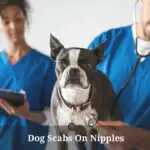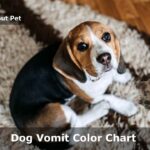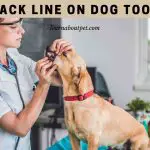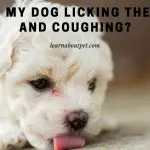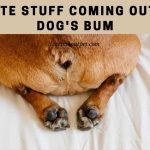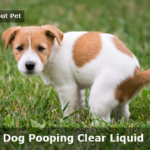Some dogs have nipples that are inverted. And at times, such inverted nipples may develop infections. In this article, you will find information on the causes, symptoms, treatments and prevention strategies for those infections that affect dog inverted nipples.
A dog inverted nipple infection occurs when pathogens (such as bacteria) find their way into a dog’s inverted nipple. Major symptoms may include swelling, redness as well as unusual discharges (such as pus) from the inverted nipple. Cleaning the inverted nipples regularly and properly can help in preventing the infection.
It is worth noting that an inverted nipple, by itself, is not something to worry about. Sure, dog inverted nipple cleaning can present a challenge. But the inverted nipple itself is not something to worry too much about.
Just like, say, a dog double nipple, an inverted nipple is just another natural feature in a dog.
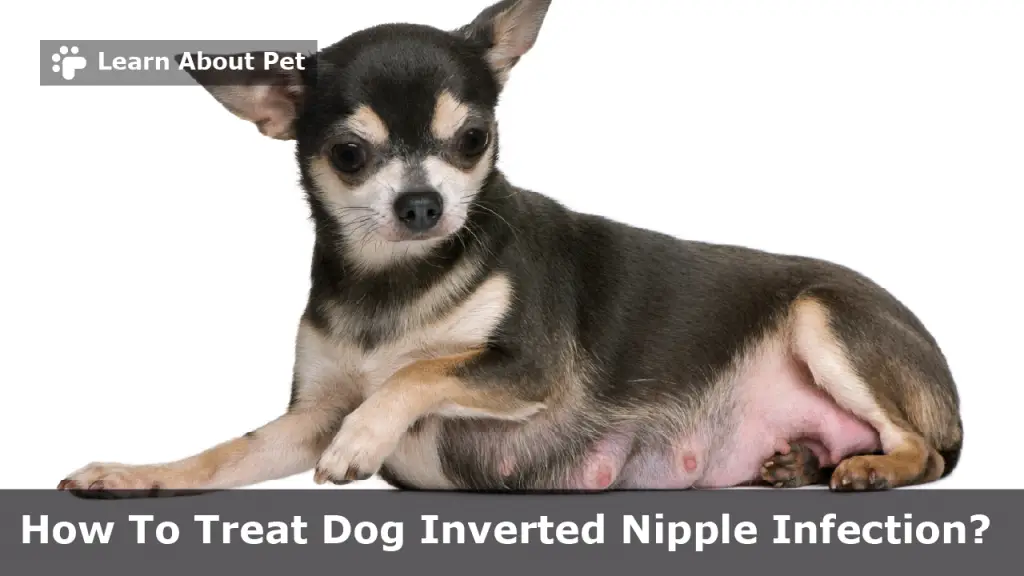
What can be worrisome is a dog nipple infection – especially when it happens to be in an inverted nipple.
For sure, the first time you notice the double nipple, you may get somewhat perturbed. That is understandable.
You may find yourself wondering, why does my dog have an inverted nipple? Is it a deformity? Can it be corrected… and so on.
Or if you catch the inversion while it is taking place, you may start wondering, why are my dogs nipples inverting? And is there a way I can stop or reverse it?
All in all, the key thing to remember is that the inverted nipple is a natural feature in the dog. What is worth worrying about is the possibility of an inverted nipple dog infection.
What Is An Inverted Nipple In A Dog?
Before proceeding any further with a discussion on dog inverted nipple infections, we first need to know what exactly an inverted nipple is.
As it turns out, an inverted nipple is simply one that is upside down.
Usually, in a dog, the nipple sticks out from the skin. It points downwards, at more or less a straight angle.
But in a dog with an inverted nipple, that nipple will be upside down. Its appearance will therefore be the exact opposite of what you would otherwise except in a normal dog nipple.
In actual fact, rather than there being a nipple sticking out from the dog’s skin, what you find (in case of an inverted nipple) is a sunken hole.
So you know that the nipple has gone inwards, rather than pointing outwards. The nipple is upside down. So it is an inverted nipple.
Are inverted nipples something to worry about? The answer is no, unless they happen to have infections or other issues.
Nonetheless upon discovering the nipple inversion phenomenon, the key question you are likely to be having is, how do I clean my dogs an inverted nipple?
Figuring out how to clean inverted nipples can be hard, considering the structure of these nipples. Yet it is so essential.
With that understanding of what an inverted nipple in a dog is, we can now proceed to learn more about the nipple’s infection.
[mv_video doNotAutoplayNorOptimizePlacement=”false” doNotOptimizePlacement=”false” jsonLd=”true” key=”vdxomsydrabvptkkdn2r” ratio=”16:9″ thumbnail=”https://mediavine-res.cloudinary.com/v1652554255/ncsxnklhwo2cl11ac9te.jpg” title=”How To Treat Dog Inverted Nipple Infection?” volume=”10″]
What Is A Dog Inverted Nipple Infection?
At the most basic level, we may define a dog inverted nipple infection as the invasion (of the nipple itself) by pathogens – such as bacteria.
When there is invasion of the nipple by such pathogens, disease develops.
You may thereafter find yourself complaining “my dogs nipple is severally swollen. She has an inverted nipple and seems to be in pain”.
Or you may end up with inverted dog nipples that are bloody with scabbing.
The pathogens may also cause dog inverted nipple crusties to break up, sometimes with discharge such as pus.
Or the nipple may start turning black. Then you start wondering, why is my dog’s nipple turning black? And the reason turns out to be due to the inverted nipple infection.
If it is a case of a nursing dogs nipples turning black, it can be particularly worrisome. But even a male dog inverted nipple infection can still be alarming.
So the bottom-line is that an inverted nipple infection is the invasion of the nipple in question by pathogens such as bacteria.
What May Cause A Dog Inverted Nipple Infection?
Most cases of dog inverted nipple infections seem to be due to improper cleaning. Or total lack of cleaning.
Usually, when you look closely at a newly infected inverted nipple dog case, you discover that there was improper cleaning. Or total absence of cleaning.
This is usually the case – with a male dog nipple infection or a female dog nipple infection.
Without proper cleaning, you soon have black gunk around dogs nipples. So this is some sort of waxy nipple build up.
That may eventually worsen, into a situation where you now have a smelly inverted nipple.
At this point, pathogens are likely to come en mass, leading to a nasty infection.
But there are cases where you clean a dog’s nipple as well as possible, yet it still develops an infection.
This can get you wondering, my dog’s nipple is infected, yet I always clean it thoroughly and regularly.
Such cases may be due to other issues: like, for instance, if the dog’s immunity is not very good.
But most cases of inverted dog nipple infections are due to improper (or total lack of) cleaning.

What Are The Signs Of A Dog Inverted Nipple Infection?
Normally, wherever there is a dog nipple infection, there will be lots of swelling.
Further, dog inverted nipple infections often cause considerable redness.
And we also often see unusual discharges in dogs that have inverted nipple infections.
Therefore if you were wondering, how do I know if my dogs nipples are infected, those are the telltale signs to watch out for.
Besides the classic signs of swelling, discharges and redness, there are other possible manifestations of inverted dog nipple infections.
For instance, what causes a female dogs nipples to turn black? Sometimes an infection can be the reason for it. Therefore this can be a sign.
So with regard to what causes a female dog’s nipples to turn black, that is one of the possibilities.
Further, the infection may cause itchiness. Thus what makes male dog nipples itchy may be this sort of infection.
In fact if you research on why would a male dog have nipples that are itchy, you find that infection is a strong possibility.
Even unusual crustiness can be a sign of an underlying infection. Thus if you were wondering, why are my male dogs nipples crusty, this can be a possibility.
Thus if my dog has crusts forming around her nipples , I would consider infection as a possibility.
Or if you find scabs, and are wondering, why are there scabs on my dog’s nipples, it could be a sign of infection.
Generally though, if you find a dog inverted nipple swollen, red or having an unusual discharge, you can almost be sure that there is an infection.
How Is A Dog Inverted Nipple Infection Diagnosed?
There are two main ways in which vets usually go about diagnosing dog inverted nipple infections.
First is by simply examining the dog inverted nipples closely.
And second is by carrying out lab tests. The tests may be on any discharges from the dog nipples in question.
Sometimes, when you go to a vet and say, “I just found something really weird on my dog nipples”, the vet may immediately start suspecting an infection.
The vet then examines the dog’s inverted nipples, searching for things like swelling, unusual discharges (like pus) or redness.
If the vet finds any of those, he may proceed to order for lab tests, to confirm the diagnosis.
So, for instance, the vet collects some of the discharge from the inverted nipple carefully. Then he checks it under a microscope, for pathogens.
One may ask, can a male dog’s nipple get infected? And the answer is ‘yes’. That is a possibility. Infections are more common in female dogs’ nipples. But they do occur in male dogs’ nipples at times as well.
Whatever the case, for the vet, it is normally not just enough to know that there is an infection. He also has to figure out exactly what type of infection it is.
Only then can he work out how to treat inverted nipples on dog, if there is infection in them.
Thus knowing the specific type of infection is essential.
Mastitis in dogs is common and very worrisome, and often has to be ruled out.
Sometimes though, what the analysis may reveal is just a simple infection affecting the inverted nipple’s skin.
All in all, dog nipple infections diagnosis is typically through clinical examination and lab tests.
How Is A Dog Inverted Nipple Infection Treated?
Treatment for a dog inverted nipple infection depends on what type of infection it is. It also depends on what type of pathogen is causing it.
So those are key considerations, when working out how to treat inverted nipples on a dog.
If the infections are due to bacterial invasions, treatment will typically be through the use of antibiotic medications.
And if the infections are due to fungal invasions, treatment will usually entail the use of antifungal medications.
Clinical examination of the nipples may just reveal that they have infections. Then lab tests reveal the nature of the pathogen behind the infection.
That then leads to the development of a roadmap on how to best care for inverted nipples in dogs, if there are infections on them.
How Can You Prevent A Dog Inverted Nipple Infection?
There are several strategies that can be helpful in the prevention of a dog nipple infection.
One very useful strategy is that of cleaning the dog’s inverted nipples thoroughly and in a regular manner.
How do you clean a dog’s nipples properly, if they are upside down (with inversion)? One approach is to gently squeeze any gunk that builds up in them. Then apply an antiseptic.
Another useful approach is to use baby wipes, with antiseptic solution, to rub both the nipples and the area around them deeply.
So that is really how to clean a dog’s inverted nipples properly.
If you don’t have antiseptic solution, you can use Epsom salts or really anything with potent antiseptic properties.
On another note, you need to ensure that the dog’s immunity is in good form. That you can do by removing stressors from the dog’s life, giving it a proper balanced diet and so on.
A dog with a tip top immunity system is unlikely to suffer from an inverted nipple infection easily.
Final Verdict – Dog Inverted Nipple Infection
We say that a dog has an inverted nipple if the nipple in question takes an ‘upside down’ orientation.
An inverted nipple may develop an infection. This is when pathogens (such as bacteria or fungi) invade it, overcome the body’s immunity, and thereafter induce a disease process.
Improper cleaning is often the cause of such dog nipple infections. But even with proper cleaning, such infections may develop in dogs that happen to have immunity problems.
Signs of a dog inverted nipple infection usually including things like swelling, unusual discharges (like pus) and redness.

Diagnosis of the nipple infections in dogs is normally through clinical examinations alongside last tests.
Treatment for a dog inverted nipple infection may entail the use of antibiotic, antifungal or other types of medications.
We can prevent dog inverted nipple infections through proper cleaning of the nipples and the areas around them.
Trying to have the dog’s immunity in good form at all times can also be helpful, in keeping these sorts of infections at bay. As long as the immunity is great, the dog can overcome a lot of infections naturally or with a little DIY help at home itself. Otherwise, you may have to go visit a Vet to get your dog cured.
As a pet lover, make sure to learn about pet more and give your pet dog a good and comfortable life!

Welcome to Learn About Pet. My name is Rajkumar Ravichandran and I love all pets, travel, and amazing food. I write about my passion and personal experience caring for multiple pets in this blog! ❤️
Post Disclaimer
DISCLAIMER: THIS BLOG OR WEBSITE, "Learn About Pet", DOES NOT PROVIDE YOU WITH MEDICAL ADVICE AND IS NOT A SUBSTITUTE FOR MEDICAL ADVICE. ALWAYS GET IN TOUCH WITH YOUR PERSONAL VETERINARIAN AND USE INFORMATION HERE AS GENERAL ADVICE.
The information, including but not limited to, text, graphics, images and other material contained on this website are for informational purposes only. No material on this site is intended to be a substitute for professional veterinary advice, food recommendation, diagnosis, or treatment. Always seek the advice of your veterinarian or other qualified health care provider with any questions you may have regarding a medical condition or for pet food related questions.

